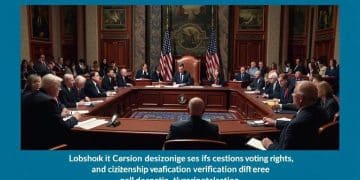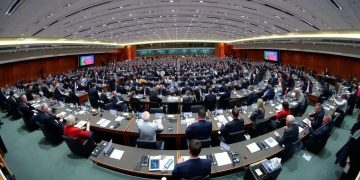Election analysis: understanding the impact on democracy

Anúncios
The role of public perception in elections is critical, as media coverage, polling data, and social media interactions shape how candidates are viewed, influencing voter decisions and overall election outcomes.
Election analysis is essential in understanding how results influence democratic processes. Have you ever wondered how your vote fits into the bigger picture? This article delves into the critical elements shaping elections today.
the importance of election analysis
The importance of election analysis cannot be overstated. It helps us understand how electoral outcomes impact society and governance. By analyzing past elections, we can identify patterns and trends that influence future voting behavior.
This process is vital as it ensures that every vote matters. Analyzing elections enables us to grasp how demographic factors and regional differences play into results. As we delve into this topic, we will explore various aspects that underline the significance of thorough election analysis.
Understanding electoral trends
Election analysis reveals valuable insights into changing voter preferences. It allows political analysts and campaigners to adjust their strategies accordingly. Key trends often include:
- Shifts in voter turnout rates among different demographics.
- The impact of critical issues such as the economy or healthcare.
- Regional voting patterns that may influence national results.
Recognizing these trends can help parties align their platforms with the electorate’s desires. Moreover, understanding historical voting patterns aids political scientists in predicting future outcomes, ultimately shaping election strategies.
Enhancing voter engagement
By communicating findings from election analysis, stakeholders can enhance voter engagement. Engaged voters are more likely to participate and make informed decisions. This can be essential in areas where voter apathy affects turnout.
Election analysis also empowers citizens by providing data-driven insights. For instance, when citizens understand how policies directly affect their lives, they are more inclined to make their voices heard. This grassroots involvement fosters a healthier democratic process.
The data collected during elections provides a wealth of information to policymakers, offering a clear view of public sentiment. Hence, the interpretation of this data plays a crucial role in shaping future policies.
As we continue to analyze elections deeply, we unveil layers of complexity in public opinion and voting behavior. This multi-faceted approach enables us to appreciate the delicate balance between power and public sentiment.
In summary, the importance of election analysis goes far beyond mere numbers. It informs strategies, enhances engagement, and ultimately contributes to a stronger democracy.
key factors influencing election outcomes

The key factors influencing election outcomes are numerous and complex. Understanding these factors is essential for predicting how elections will unfold. Voter behavior, economic conditions, and media influences play significant roles in shaping election results.
One major factor is voter demographics. Different groups may prioritize various issues, affecting how they vote. For example, younger voters often emphasize climate change, while older voters might focus on Social Security. These distinct priorities highlight the diversity in the electorate.
Economic conditions
The economy is another critical element in elections. When the economy is strong, incumbents typically fare better at the polls. Conversely, economic turmoil can lead to significant losses for those in power. Voters often connect their personal financial health to the broader economic trends, guiding their choices on Election Day.
- High unemployment rates can trigger dissatisfaction with current leadership.
- Inflation can shift voter priorities, focusing attention on economic policy.
- Economic growth may boost confidence in the incumbents’ ability to govern.
Additionally, issues like healthcare and education often become decisive elements during campaigns. Candidates who address these topics effectively can sway undecided voters who may not have strong party affiliations.
Media influences
The media plays a crucial role in shaping public perception of candidates. From television ads to social media campaigns, how candidates are portrayed can significantly impact their popularity. Negative campaigning can turn voters away, while positive coverage can enhance a candidate’s image.
Moreover, the rise of social media has changed the landscape of political communication. Candidates now engage directly with voters, which can be a double-edged sword. While it allows for quicker responses and greater interaction, it also opens the door for misinformation to spread rapidly.
In conclusion, multiple factors intertwine to influence election outcomes. By understanding these key elements, analysts can gain insights into how future elections may unfold and help candidates tailor their campaigns to meet the expectations of the electorate.
how data shapes electoral strategies
How data shapes electoral strategies is a crucial aspect of modern campaigning. In today’s political landscape, data plays an instrumental role in how candidates and parties approach elections. Through careful analysis of various data sources, campaigns can effectively target voters and tailor their messages.
One important factor is voter data analytics. By collecting information on demographics, past voting behavior, and preferences, campaigns can identify key groups to engage. This targeted approach allows candidates to focus their resources where they are most needed. For instance, data may reveal that younger voters prioritize environmental issues. Consequently, campaigns can adjust their messaging to resonate with this audience.
Micro-targeting voters
Micro-targeting is a strategy that relies heavily on data analysis. It involves segmenting the electorate into smaller groups based on specific characteristics. Political teams use social media, surveys, and polling data to create distinct profiles for different voter segments.
- By identifying key issues relevant to each segment, campaigns can craft personalized messages.
- Ads can be tailored to highlight specific policies that matter most to target groups.
- Data-driven strategies ensure resources are allocated efficiently to maximize voter outreach.
This level of targeting helps candidates connect with voters on a more personal level, increasing the chances of mobilizing support. Additionally, ongoing data collection during the campaign allows for real-time adjustments to strategies as needed.
Predictive modeling
Another significant aspect is predictive modeling, which uses historical data to forecast future outcomes. Campaigns analyze past election results and various influencing factors to predict how different scenarios might unfold.
This approach enables teams to identify potential swing voters and areas where they need to increase efforts. By understanding how various elements influence voter decisions, campaigns can proactively address concerns and highlight relevant successes.
Moreover, predictive analytics helps anticipate voter turnout, allowing campaigns to prepare adequately for logistical needs on Election Day. As a result, having a robust data strategy can significantly enhance a candidate’s chances of success.
Ultimately, the integration of data into electoral strategies is transforming how campaigns operate. By utilizing sophisticated analytics, political parties can forge stronger connections with the electorate and create more impactful campaign messages.
the role of public perception in elections

The role of public perception in elections is vital for understanding how candidates are viewed by voters. Public opinion can shape election outcomes significantly. How people perceive a candidate’s character, policies, and overall image often influences their voting decisions.
Media coverage plays a key role in shaping public perception. News articles, interviews, and debates can highlight specific issues or traits of candidates, which can sway opinions. When candidates are portrayed positively, they are more likely to gain support. Conversely, negative coverage can harm their chances at the polls.
Public opinion polls
Public opinion polls help gauge how the electorate feels about candidates and issues. These polls provide insight into shifting perceptions over time. Campaigns often use this data to adjust their messaging and strategies to better align with voter sentiment.
- Polling data can reveal which issues matter most to voters.
- It helps candidates refine their platforms to meet public expectations.
- Understanding voter sentiment allows for targeted outreach efforts.
Moreover, polls can create a bandwagon effect where candidates perceived as front-runners gain increased support simply because people want to back a winner. This highlights how perception can drive behavior in voters.
Social media’s impact
In today’s digital age, social media significantly influences public perception. Candidates can communicate directly with voters, showcasing their personalities and stances on issues. This unfiltered access helps shape how voters connect with candidates.
Additionally, social media allows for rapid dissemination of information—both positive and negative. Misinformation can spread just as quickly, impacting public perception negatively and creating an environment of distrust. Thus, candidates must manage their online reputation carefully.
Public perception in elections is a dynamic interplay between media influence, polling data, and social media engagement. Candidates who understand and navigate this complex landscape are better positioned to win voter support. As perceptions shift, so do the strategies candidates must employ to remain relevant and appealing to their constituents.
In conclusion, understanding the intricate dynamics of public perception is vital to navigating elections effectively. Voter opinions are influenced by media coverage, social media interactions, and polling data. Candidates must stay attuned to these elements to connect genuinely with voters. By carefully managing their image and addressing the key issues that resonate with the electorate, they can enhance their chances of success. Ultimately, a strong grasp of public perception can shape strategies that lead to favorable election outcomes.
FAQ – Frequently Asked Questions about Public Perception in Elections
How does media coverage impact election outcomes?
Media coverage shapes voter perceptions of candidates, influencing public opinion and potentially swaying election results.
What role do opinion polls play in elections?
Opinion polls help gauge public sentiment and guide candidates in adjusting their strategies to better align with voter preferences.
How does social media affect voter engagement?
Social media allows candidates to connect directly with voters, enabling them to share their messages and engage in real-time discussions.
Why is understanding voter sentiment important?
Understanding voter sentiment allows candidates to tailor their messages to address the specific concerns and interests of their constituents.






